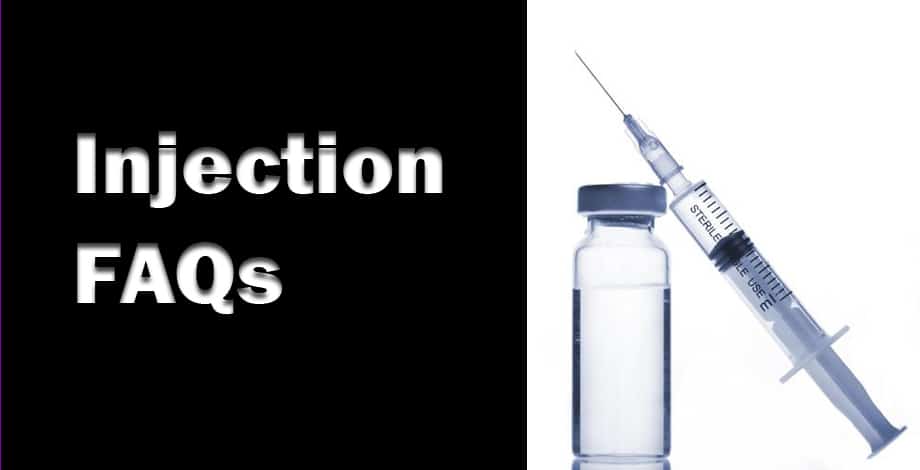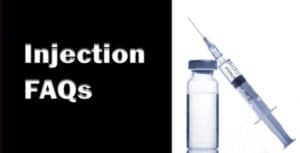ANABOLIC STEROIDS, HEALTH, NOTEWORTHY ADVICE
INJECTION FAQ
Last Updated on March 18, 2024 by
INJECTION FAQ
For many of you, this is common knowledge, but I’m sure that some of you still have a few questions about this subject. If you are new to steroids, this FAQ should answer your injection questions. We will start from the very beginning…….
1cc = 1ml
Gauge: The smaller the gauge, the thicker the needle. An 18g is much thicker than a 22g.
Length: Generally 1.5″ or 1″ for our purposes.
And yes, you can mix water and oil-based steroids in the same syringe.
Now we can proceed…….
What is an intramuscular (IM) injection?
A technique to deliver a medication into muscle tissue for it’s eventual absorption into the systemic circulation. Steroids, both oil and water-based, are administered this way.
What is a subcutaneous (sub-q) injection?
A technique to deliver a medication into the soft tissue (fat) immediately underlying the skin. Insulin, HCG, and HGH are typically administered this way.
What is aspiration?
To aspirate is to withdraw fluid with a syringe. More specifically, after inserting the needle, pulling back on the plunger of the syringe for a few seconds to see if the needle is in a blood vessel. Rarely, this will be the case and a bit of blood will fill the syringe. If this happens the needle should be removed, replaced with a new one, and another injection site should be used. And yes, if there is a little blood in your syringe, it is ok to inject it along with your steroid once you have found a different spot……….it’s your own blood isn’t it?
When aspirating, nothing should come back into the syringe if you are in the right spot. Pulling back on the plunger will create a vacuum in your syringe. The oil cannot expand to fill that space, but any air bubbles in your syringe will. You may notice the tiny bubbles getting bigger and bigger as you pull back. They will return to normal size as you release the plunger. If the air bubbles do not disappear upon releasing the plunger, you have an air leak most likely caused by the needle not being screwed onto the syringe tightly enough, although on very rare occasions, the syringe or needle itself can be defective. Either way, purge the air bubbles out, put a new needle on and try it again.
Do I really need to aspirate?
Those who inject without aspirating are taking unnecessary chances. Sweating, nausea, dizziness, severe coughing, breathing difficulties, anaphylactic shock, coma or death can all result from not aspirating. Most of the time, steroid users experience dizziness and coughing fits when they inject into a blood vessel. But you need to be aware of the dangers of neglecting this simple technique that should take about 3-5 seconds of your time.
What exactly is an abscess?
Abscesses occur when an area of tissue becomes infected and the body is able to “wall off” the infection and keep it from spreading. White blood cells migrate through the walls of the blood vessels into the area of the infection and collect within the damaged tissue. During this process, pus forms (an accumulation of fluid, living and dead white blood cells, dead tissue, and bacteria or other foreign invaders or materials).
Abscesses can form in almost every part of the body and may be caused by bacteria, parasites, or foreign materials. Most of the time, it is caused by unsanitary injection techniques. On very rare occassions, it can be caused by foreign particles your gear (a greater chance of this occurs when using/making a homebrew). The abscesses that we are concerned about are usually reddish, raised, and painful.
How do they treat an abscess?
Antibiotics are often given to aid the cure of an abscess but the real cure is generally surgical. A doctor wouud open the thing up and allow the pus to drain, then the body would take care of the infection. Some have even gone so far as to “drain” their own abscesses by inserting a needle/syringe into the abscessed area and drawing out the accumulated pus, although this is not recommended.
Can I reuse the same needle?
Yes, but only if you are an idiot or cannot obtain anymore needles. There really is no need to explain why you shouldn’t re-use a needle. Common sense should kick in here, but the bottom line of re-using needles is an INCREASED CHANCE OF INFECTION. If you have trouble obtaining needles in your area, try finding a different way of getting them. The hassle of finding a source is negligible compared to the hassle of the abscess in your ass that would most-likely require a doctor and a scalpel. There are methods to “sterilize” a needle for re-use, but I will not delve into them. If you are still considering re-using a needle, re-read the above two questions.
Can I inject with the same needle I draw with?
Yes, but it is preferrable to switch the needle out with a new one. The needle dulls significantly when pushed into the rubber stopper of your vial or scraped along the bottom of your amp. You may not notice the difference if you inject into your glute, but try injecting into an area that has more nerve endings such as a delt or bicep and you will notice immediately.
Does it matter if I push the needle in fast or slow?
I would recommend slowly, but this is personal preference. A lot of people will tell you to jab the needle in quickly. These people usually stop that practice after the first time they hit a nerve going in at full speed (usually quad shots). By going in slowly, you’ll have more time to react if you hit a nerve.
Where exactly do I inject?
A picture is worth a thousand words.
What gauge needles should I use?
for drawing – 20g, 21g
18g needles are too big and they will eat up your stoppers in a hurry. A bigger hole means an increased chance of letting some little nasties into your sterile vial. Sometimes, the 18g will take out little chunks of rubber that fall nicely into your vial. That is not something you want. Imagine injecting that tiny piece of rubber into your muscle. I’ll bet the doctor would have lots of fun digging into your rmuscle trying to find it and mutilating your muscle in the process…..for injecting – 22g, 23g, 25g – for oil-based steroids, 27g, 29g – for insulin, HCG, HGH, and some water-based steroids. 21g-25g for some lower quality types of winny or suspension, higher quality versions can use a smaller needle generally.
22g and 23g are fine for glutes and quads. 25g is preferred for the smaller muscles such as delts, biceps, triceps, etc.
What length needles should I use?
Most people can get by with a 1″ needle, but if you have a higher percentage of bodyfat or are just plain big you should use a 1.5″ needle to insure that you get deep into the muscle. You should only use a 1.5″ needle for glutes, or if you have huge quads. For smaller muscle groups, 1″ is the most common, although some people like to use a 5/8″.
How many ccs can I shoot in one place?
It depends on how big you are. A general guideline is 1cc for delts, 2cc for quads, and up to 3ccs for glutes. Some do more, some do less……it all depends. After a cycle or two, you will know what your body can handle. If you are injecting into other muscles such as biceps, triceps, or calves, it’s best to start off with a small volume and work your way up.
Can I pre-load my syringes?
If at all possible, leave it in the vial or amp. If you need to pre-load, just keep in mind that the syringe must be stored safely. Nothing sucks more than having the plunger pushed in accidentally and losing some of your gear.
Which is the best brand of needle?
Terumo, B-D, and Monoject are the primary manufacturers of needles/syringes. Both Terumo and B-D have an ultra-thin wall design (the wall of the needle is thinner, so more fluid can pass through the same gauge of needle). From personal experience as well as opinions from many other steroid users, Terumo seems to be the sharpest.
Common “FREAK OUTS”
I can’t get all the tiny air bubbles out of my syringe….
As long as you tap it and get most of the air out, you will be fine. A little air intramusculary won’t hurt you. According to the USH2 by Dan Ducaine, it supposedly takes about 10ccs of air injected into a blood vessel to kill you. I wonder how the hell they figured that one out.
- I saw blood in the syringe after I pulled out….
You passed through a blood vessel and a little bit of blood entered the syringe on the way out. No biggie.
- I pulled the needle out and blood dripped/squirted out….
You passed through a blood vessel. Apply a little pressure with your alcohol swab. You’ll live.
- I pulled the needle out and oil was dribbling out….
You injected too much in one place or you didn’t inject deep enough. No biggie. Try injecting slower or leaving the needle in you for 30 seconds after you have injected it all. This should give the oil some time to dissipate so very little, if any, should dribble out.
- I injected into my quad, and my leg was twitching….
You grazed a nerve. Usually it’s a good idea to pull out and try another spot.
- I don’t think I injected deep enough….
If you think you injected into a layer of fat, don’t worry. It will just take longer for the steroid to dissipate than it would if you had injected into the muscle. Eventually it will be absorbed. Don’t let anyone tell you that you wasted it because that is not true.
- I want to mix two different steroids and combine them into one syringe. How do I do this?
Let’s say you want 1cc of deca and 1cc of test. First, draw 1cc of air and inject into your vial of deca. Withdraw 1cc of deca and pull the needle out. With the needle pointing up, draw 1cc of air into your syringe (your plunger will be at the 2cc mark – 1cc of deca in it and 1cc of air you just drew into it). With the needle pointing up, inject that 1cc of air into your vial of test. Withdraw 1cc of test. You now have 1cc of deca and 1cc of test in the same syringe. Don’t forget to change the needle before you inject.
Instructions for first-timers…..
Step 1
Wash your hands.
Step 2
Wipe the top of the vial of medication for injection with an alcohol swab.
Step 3
Remove the needle guard from the needle and syringe, saving the needle guard. Be sure you are using a proper syringe for intramuscular injections. Pull back on the syringe plunger to draw up an amount of air equal to the amount of medication that your doctor has prescribed for injection. For example, if you want to inject 2ccs of oil, then pull back 2ccs of air.
Step 4
Holding the vial of medication in an upright position, insert the needle straight through the center of the rubber stopper in the vial. Then push the plunger to discharge all the air into the vial.
Step 5
With the needle in the vial, turn the vial upside down and hold it in one hand. The tip of the needle should be in the solution. Using your free hand, pull the plunger back in a slow, continuous motion until you have drawn into the syringe the amount of medication that your doctor has prescribed.
Step 6
If air bubbles have formed in the syringe, dislodge them by gently tapping the syringe with your free hand while continuing to hold the syringe and vial in the inverted position. Bubbles should rise to the top of the syringe, and then you can push them back into the vial by moving the plunger. Double check to make sure you have the correct amount of medication in the syringe. If necessary, draw more solution into the syringe.
Step 7
Remove the needle from the vial. With the needle pointing upwards, pull back on the plunger until all oil from the needle has been pulled back into the syringe. Unscrew needle from syringe and replace with a brand new, preferrably smaller needle. Replace needle guard.
Step 8
Prepare the injection site by cleaning the area with an alcohol swab. To do this start at the center, apply pressure, and cleanse in a circular motion working outward. Do not retrace your steps.
Step 9
Wait a few seconds until the alcohol has dried. This reduces the sting. Remove the needle guard from the needle and syringe. With the needle pointing upwards, tap the syringe to dislodge the air bubbles and push the air out of the needle until you see a tiny drop of oil start to form at the tip. Hold the syringe as you would a pencil.
Step 10
Holding the syringe at a right angle (perpendicular) to the prepared injection site and insert the needle.
Step 11
When the needle is in place, slowly pull back on the plunger to see if any blood flows into the syringe. If some blood does enter the syringe (a rare occurrence), remove the needle, replace the needle with a new one, find another area to inject. Repeat Step 8.
Step 12
If no blood enters the syringe, slowly inject the medication by gently pushing the plunger until the syringe is empty.
Step 13
Remove the needle quickly. Apply pressure to the injection site with your alcohol swab. You’re done. Massage the area. . Now go do the most important parts – eat, train, and rest!
ALSO CHECK OUT THE POST ON BLOOD IN THE SYRINGE HERE

COUPON CODE: T20
COUPON CODE: ANABOLIC









